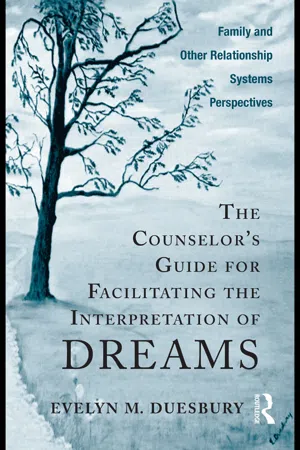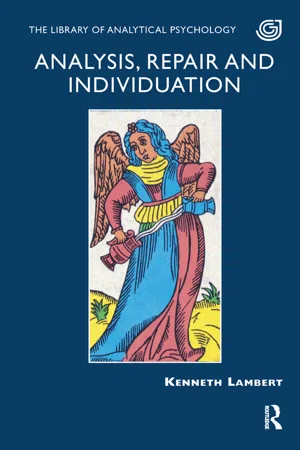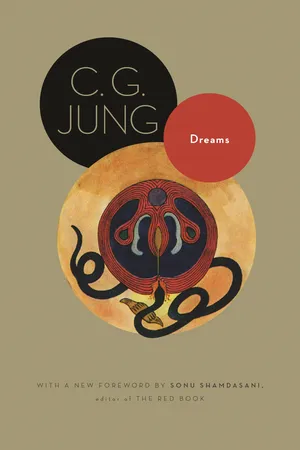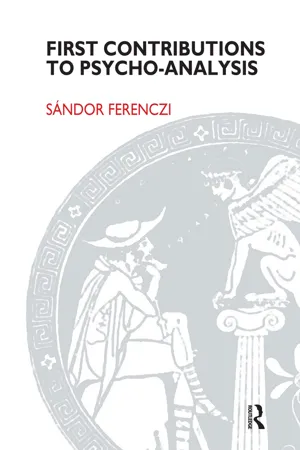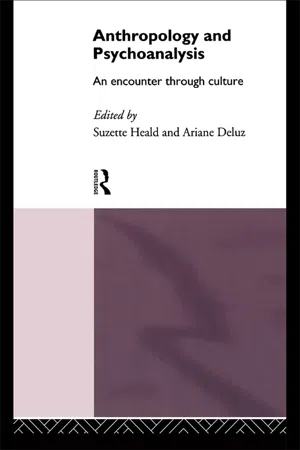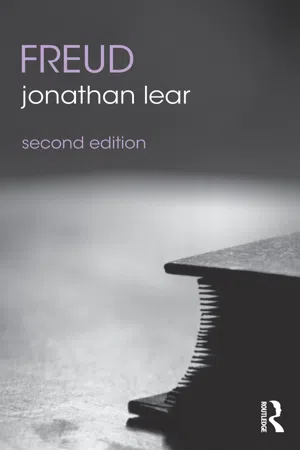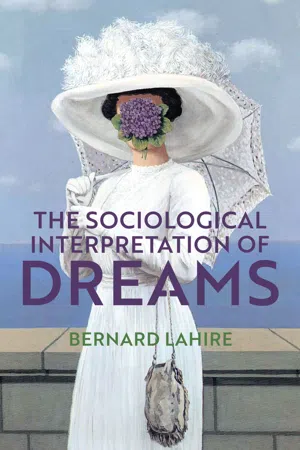Psychology
Dream Analysis
Dream analysis is a therapeutic technique used to explore the unconscious mind by interpreting the content of dreams. It is based on the idea that dreams can reveal hidden desires, fears, and unresolved conflicts. Psychologists use various methods to analyze dreams, such as free association and symbolism interpretation, to gain insight into a person's emotions and experiences.
Written by Perlego with AI-assistance
Related key terms
11 Key excerpts on "Dream Analysis"
- eBook - ePub
Sleep Disorders
Elements, History, Treatments, and Research
- Kathleen J. Sexton-Radek Ph.D., Gina Graci(Authors)
- 2021(Publication Date)
- Praeger(Publisher)
CHAPTER 10 Dreaming as a Psychological ProcessW hy do we dream, why are some dreams frightening, and why do we only remember some of our dreams? Hypotheses have abounded for years regarding the meaning and biological or neurological pathway of dreams. Some people earn a living by analyzing dreams, but what do dreams really mean, and what is the current dream landscape? The symbolic meaning of dreams is called the latent content of dreams, and many people believe there are hidden messages in dreams. Some scientists believe that dreaming is related to depression, and some therapists postulate that if the unconscious meaning of dreams can be interpreted, then psychological distress could be relieved (Cherry, 2020). This chapter will explore dreaming as a psychological process.A dream is defined as a physiologically and psychologically conscious state that occurs during sleep. It is often characterized by a rich array of endogenous sensory, motor, emotional, and other experiences (American Psychological Association [APA], 2020). Dreams mainly occur in rapid eye movement (REM) sleep and may be logical or illogical. Dream interpretation is the attempt at finding meaning from dreams as it applies to an individual’s life.Sigmund Freud believed that the meaning and content of dreams were heavily encrypted and hard to translate (Lyon, 1990). The hidden meaning of dreams played an important role in Freud’s psychoanalytic theory, and he believed that bringing the hidden meaning of a dream into conscious awareness could relieve psychological distress (Freud, 1913). For instance, Freud believed that the latent content of a dream was not only suppressed but hidden by the subconscious mind to protect the person from thoughts and feelings that were hard to cope with (Cherry, 2020).While the function of sleep is hypothezied to be based on restorative properties, there is no concluding evidence that this is true. The early work of Dr. Rosalind Cartwright (the Grandmother of Sleep) showed the scientific measurement of sleep and dreaming, primarily dreams and the process of dreaming. “Dreams,” wrote Cartwright, “are our private perceptions which cannot be validated or shared by others” (Cartwright, 1977). She also postulated that dreams may “provide us with a direct cure for certain mental problems long before anyone determines exactly what sleep and dreaming are for” (Lyon, 1990). - eBook - ePub
The Counselor's Guide for Facilitating the Interpretation of Dreams
Family and Other Relationship Systems Perspectives
- Evelyn M. Duesbury(Author)
- 2011(Publication Date)
- Routledge(Publisher)
Strengths of cognitive behavior therapies and strengths of the facilitation of clients’ dream interpretations can be combined. Cognitive behavior therapies concentrate on events, thoughts, and emotions. Dreams connect to events, thoughts, and emotions. Counselors whose skills include the facilitation of clients’ dream interpretation naturally extend their services in helping their clients alleviate stress.SUMMARY
This chapter traces the use of dreams from ancient times to today. Many lands and cultures provide examples of work with dreams, including those of Native Americans, Australian Aborigines, Hebrews, Greeks, Romans, Africans, Chinese, Indians, Egyptians, and Japanese.Although use of dreams was disparaged and uprooted in Western Christian cultures, credibility began to reemerge during the 19th and 20th centuries. Freud’s psychoanalytic emphasis on the use of dreams influenced his colleagues, Jung and Adler, although both developed dream interpretation styles that deviated from Freud’s. Adler’s influence resulted in Boss’s development of an existentialist approach to dream interpretation. Perls developed the Gestalt dream interpretation approach. More recent developers of dream interpretation models include Hall, Ullman, Cartwright, Delaney, Hill, and Siegel and Bulkeley.A brief discussion of the neurology of dreaming is included to help us understand a few of the “whys” that dream scenarios vary from waking-life cognitions. Increased acceptance of qualitative data and dreamers’ amplified involvement in working with their dreams is giving today’s dreamers expanded opportunities to use their dreams for self-discovery. Dreams incorporate experiential information beyond what dreamers grasp in waking thoughts. Thus, practicing counselors who know how to facilitate their clients’ interpretation of dreams yield expanded opportunities for them to help their clients who bring dreams to counseling sessions.SELF-STUDY QUIZ: CHAPTER 1
- What proportion of people dream?
- Dreams have been used for guidance since ancient times. True _____ False _____
- eBook - ePub
- Kenneth Lambert(Author)
- 2018(Publication Date)
- Routledge(Publisher)
Chapter Eight Dreams and dreamingNo book on analysis, repair and individuation can avoid a consideration of the way in which analysts can use their patients’ communication to them of their dreams and dreaming to increase their understanding of the dynamic process involved. They will be told dreams whether they ask for them or not, although the patients’ motives for telling them are likely to be extremely varied. Indeed, considerable advances in the understanding of dreaming and the use made of it in their patients’ communications are being made by analysts of all schools. Furthermore, outside the field of analysis, light is being shed by the sleep laboratory experimenters and by brain neurophysiologists on the nature and purpose of dreams and their possible function in the maintenance of psychological health, whether interpreted or not.This chapter will sketch out changes in psychoanalytic thought about dreams and then try to bring out whatever seems relevant to analysts from the two sets of experimenters already mentioned. It will then describe the contribution of classical analytical psychology to the subject and show how more recent analytical psychology has modified and reslanted its earlier views and reconsidered ways of making use of dreams and dreaming in the analytical interpretation of their patients’ situation. Two case-histories are presented to illustrate these new developments.The Psychoanalytic Tradition
The action of Emmy von N. in presenting her dreams to Freud nearly eighty years ago led him towards a point where he could begin to talk of the dream as “the royal road to the knowledge of the unconscious activities of the mind”. This was, on the whole, a revolutionary idea for a mind of his time, rationalist and scientifically orientated as it was, although a shade too topographical, static and fixed for present-day tastes. Much more dynamic was his theory that during sleep we experience a lessening of the tension that accompanies the daytime inhibition and control of primary-process-originated impulses to action. That tension is further lessened by giving such impulses some expression on the level of phantasy or dream. These drives are postulated to provide the latent content of the dream, obscured from consciousness by a manifest content that employs condensation, displacement and the language of signs and symbols—a sort of wish-fulfilling “under the counter” manoeuvre. - eBook - ePub
Jung Extracts
(From Volumes 4, 8, 12, and 16 of the Collected Works of C. G. Jung)
- C. G. Jung, R. F.C. Hull, R. F.C. Hull(Authors)
- 2012(Publication Date)
- Princeton University Press(Publisher)
The use of dream-analysis in psychotherapy is still a much debated question. Many practitioners find it indispensable in the treatment of neuroses, and consider that the dream is a function whose psychic importance is equal to that of the conscious mind itself. Others, on the contrary, dispute the value of dream-analysis and regard dreams as a negligible by-product of the psyche. Obviously, if a person holds the view that the unconscious plays a decisive part in the aetiology of neuroses, he will attribute a high practical importance to dreams as direct expressions of the unconscious. Equally obviously, if he denies the unconscious or at least thinks it aetiologically insignificant, he will minimize the importance of dream-analysis. It might be considered regrettable that in this year of grace 1931, more than half a century after Carus formulated the concept of the unconscious, more than a century after Kant spoke of the “illimitable field of obscure ideas,” and nearly two hundred years after Leibniz postulated an unconscious psychic activity, not to mention the achievements of Janet, Flournoy, Freud, and many more—that after all this, the actuality of the unconscious should still be a matter for controversy. But, since it is my intention to deal exclusively with practical questions, I will not advance in this place an apology for the unconscious, although our special problem of dream-analysis stands or falls with such an hypothesis. Without it, the dream is a mere freak of nature, a meaningless conglomeration of fragments left over from the day. Were that really so, there would be no excuse for the present discussion. We cannot treat our theme at all unless we recognize the unconscious, for the avowed aim of dream-analysis is not only to exercise our wits, but to uncover and realize those hitherto unconscious contents which are considered to be of importance in the elucidation or treatment of a neurosis. Anyone who finds this hypothesis unacceptable must simply rule out the question of the applicability of dream-analysis.295But since, according to our hypothesis, the unconscious possesses an aetiological significance, and since dreams are the direct expression of unconscious psychic activity, the attempt to analyse and interpret dreams is theoretically justified from a scientific standpoint. If successful, we may expect this attempt to give us scientific insight into the structure of psychic causality, quite apart from any therapeutic results that may be gained. The practitioner, however, tends to consider scientific discoveries as, at most, a gratifying by-product of his therapeutic work, so he is hardly likely to take the bare possibility of theoretical insight into the aetiological background as a sufficient reason for, much less an indication of, the practical use of dream-analysis. He may believe, of course, that the explanatory insight so gained is of therapeutic value, in which case he will elevate dream-analysis to a professional duty. It is well known that the Freudian school is of the firm opinion that very valuable therapeutic results are achieved by throwing light upon the unconscious causal factors—that is, by explaining them to the patient and thus making him fully conscious of the sources of his trouble. - eBook - ePub
- C.G. Jung(Author)
- 2020(Publication Date)
- Routledge(Publisher)
1 DREAM-ANALYSIS IN ITS PRACTICAL APPLICATIONThe use of dream-analysis in psychotherapy is still a much-debated question. Many practitioners find it indispensable in the treatment of neuroses, and ascribe as much importance to the psychic activity manifested in dreams as to consciousness itself. Others, on the contrary, dispute the value of dream-analysis, and regard dreams as a negligible by-product of the psyche.Obviously, if a person holds the view that the unconscious plays a leading rôle in the formation of neuroses, he will attribute practical significance to dreams as direct expressions of the unconscious. If, on the other hand, he denies the unconscious or thinks that it has no part in the development of neuroses, he will minimize the importance of dream-analysis. It is regrettable that in this year of grace 1931, more than half a century since Carus formulated the concept of the unconscious, over a century since Kant spoke of the “immeasurable . . . field of obscure ideas”, and nearly two hundred years since Leibniz postulated an unconscious psychic activity, not to mention the achievements of Janet, Flournoy and Freud—that after all this, the actuality of the unconscious should still be a matter for controversy. Since it is my intention to deal exclusively with questions of practical treatment, I will not attempt in this place a defence of the hypothesis of the unconscious, though it is obvious enough that dream-analysis stands or falls with this hypothesis. Without it the dream appears to be merely a freak of nature, a meaningless conglomerate of memory-fragments left over from the happenings of the day. Were the dream nothing more than this, there would be no excuse for the present discussion. We must recognize the unconscious if we are to treat of dream-analysis at all, for we do not resort to it as a mere exercise of the wits, but as a method for uncovering hitherto unconscious psychic contents which are causally related to the neurosis and therefore of importance in its treatment. Anyone who deems this hypothesis unacceptable must simply rule out the question of the practicability of dream-analysis. - eBook - ePub
- Sandor Ferenczi(Author)
- 2018(Publication Date)
- Routledge(Publisher)
CHAPTER IIITHE PSYCHOLOGICAL ANALYSIS OF DREAMS 1
A PHENOMENON not rare in the evolution of science is that professional men of erudition, with all the help at their disposal, with all the implements of their knowledge and ability, combat some principle of popular wisdom which is, on the other hand, defended by the people with equal tenacity, and that finally science is forced to recognise that in essentials the popular conception, and not its own, is the correct one. It would be especially worthy of investigation to discovery why it is that science, on its gradually mounting path, progresses in an irregular zigzag line, which at times comes close to the popular view of the world, and at times quite departs from it.I mention this peculiar phenomenon for the reason that the latest investigations of dreams, those remarkable and bizarre manifestations of mental life, have laid bare facts that compel us to abandon our former views regarding the nature of dreams, and, with certain limitations, to return to the popular conceptions.The people have never given up a belief in the significance of dreams. The oldest writings that have been preserved to us, hewn out in stone in praise of the old Babylonian kings, as also the mythology and history of the Hindoos, Chinese, Aztecs, Greeks, Etruscans, Jews, and Christians, take the point of view held to-day by the people, that dreams can be interpreted. The interpretation of dreams was for thousands of years a special science, a particular cult, whose priests and priestesses often decided the fate of countries and called forth revolutions that changed the history of the world. This now antiquated science rested on the unshakable belief that dreams, though in a concealed way and by obscure analogies, were quite capable of being interpreted by the initiate and revealed the future, and that by these nocturnal phenomena the powers above desired to prepare mortals for approaching events of importance. In the lower ranks of the populace the dream book, that curious survival of ancient Babylonian astrology, still enjoys to-day great popularity. Although the details of the dream-books differ in the different countries, they have to be considered as products of the common folk-spirit. - eBook - ePub
Anthropology and Psychoanalysis
An Encounter Through Culture
- Ariane Deluz, Suzette Heald(Authors)
- 2002(Publication Date)
- Routledge(Publisher)
Part II The analysis of dreams
Passage contains an image
6 Dream imagery becomes social experience The cultural elucidation of dream interpretation1
Iain Edgar
Dreaming is a universal aspect of being human. It appears to be the most private and hidden activity which is usually perceived as being both unpredictable and often incomprehensible. Yet most human societies have sought to understand dream imagery and many have accorded such imagery and its interpretations high, even prophetic, significance. The paradoxical and ambivalent position of the dream is well illustrated in western industrialised societies where, on the one hand, ‘interpreting dreams’ is seen as a highly specialised task reserved for psychoanalysts and needing a long and challenging training. On the other hand, dreaming is denigrated as being wholly illusory, as being just a ‘dream’ and of no consequence.Tedlock (1987a) has traced the origin of western disregard of the value of dreaming back to Aristotelian scholasticism. The development of Cartesian dualism in the seventeenth century set the seal on the relegation of dream imagery to the realm of the unreal. The ‘oppositional dichotomy’ (Tedlock, 1987a:2) thus erected between subjective and objective reality, reality and unreality, meant the exclusion of dreaming from serious consideration in the west until the twentieth century. Freud’s development of psychoanalysis, his use of dream imagery and his conceptualisation of the unconscious clearly started a new era in terms of the evaluation of the dream. Such a historical and negative evaluation of the dream is not however universal. In the Indian Hindu tradition dreaming is placed above waking reality in the hierarchy of realities (Tedlock, 1987a:3). In the Islamic Sufi tradition a form of reality is identified which is midway between sensibility and spirituality. This is identified by Corbin (1966) as the ‘imaginal world’ which is an autonomous world of imagery and forms accessible through both dreaming and techniques of active imagination (Price-Williams, 1987). Moreover, outside the great world religious traditions there is abundant evidence from anthropologists to show that many non-industrialised societies value and use dream imagery as part of their participatory experience of reality (Tylor, 1871; Firth, 1934; Devereux, 1951; Hallowell, 1966; Tedlock, 1987a; Herdt, 1987; Mannheim, 1987). - 12 This does not mean that no matter what the dreamer says, he must be right. The point is, rather, that ultimately the meaning of a dream must be given by the dreamer. The analyst, then, must be facilitating a process by which dreamers can come to say for themselves what the meaning of the dream is. And so, the analyst should not be in the position of telling analysands what their dreams mean.Taken together, these three principles imply a remarkable conclusion: that Freud is primarily concerned not with the interpretation of dreams, but the self-interpretation of dreamers . It is for the dreamers to say what their dreams mean, and they do this by explaining (to themselves) how the dream fits into their lives as a whole and why it matters.
3 Freud's self-interpretation
In fact, The interpretation of dreams is the self-interpretation of a dreamer – Freud himself. Throughout the book the most illustrative analyses of dreams come from Freud’s own experience. Indeed, this book is constitutive of Freud’s self-analysis: he is here declaring for himself what his own dreams mean. So while the official rhetoric is that this is a scientific treatise on the nature of dreams, unofficially the book persuades by being exemplary. In effect, Freud is saying ‘Here is how I uncover the meaning of my own dreams; follow my example and you will be able to say to yourself who you are.’Consider Freud’s account of one of his own dreams, the dream of the botanical monograph:I had written a monograph on a certain plant. The book lay before me and I was at the moment turning over a folded colored plate. Bound up in each copy there was a dried specimen of the plant, as though it had been taken from a herbarium.13 - eBook - ePub
Freud: The Key Ideas
Psychoanalysis, dreams, the unconscious and more
- Ruth Snowden(Author)
- 2017(Publication Date)
- Teach Yourself(Publisher)
• Dreams often occur in groups with a common underlying theme. An insight into one dream may unravel a whole series of dreams.• Something that seems trivial or superficial in a dream may actually be masking a deep insight.• Similarly, it is important for the analyst to pay attention to all the client’s remarks, however trivial they may seem on the surface.However, Freud also warns that dream interpretation is not always easy. The elements of a dream can be interpreted in various ways and it is often doubtful which method to use in deciphering a given element:• Some elements can be taken in a positive or a negative sense – by this, Freud seems to mean that a dream image may actually indicate its own opposite, for example hot/cold, fire/water and so on.• An element may be interpreted historically – it is a recollection of something that has actually happened to the dreamer.• The interpretation is sometimes to do with the wording – in other words, the element may contain a pun or other wordplay; for example, you might dream of a rather undesirable acquaintance who is wearing a pair of sunglasses that bear the trade name ‘Wide Boy’.• Some elements can be interpreted symbolically.Freudian symbolsFreud believed that much of a dream’s content was disguised by means of symbols. Freudian symbols within dreams have become one of the most well-known aspects of psychoanalytic thinking. Freud believed that symbols had fixed meanings common to all humans, and therefore under certain circumstances it was possible to interpret a dream without actually questioning the dreamer, provided one knew a little about his personality, the circumstances of his life and the impressions that preceded the occurrence of the dream. However, symbols often have more than one meaning, so correct interpretation can only be arrived at by analysing the dream. To understand symbols in a dream, Freud used a combination of two methods, which were: - Part III The Practical Use of Dream-Analysis
Passage contains an image
1
The Practical Use of Dream-Analysis1DOI: 10.4324/9780203165935-81 [Delivered as a lecture, “Die praktische Verwendbarkeit der Traumanalyse,” at the 6th General Medical Congress for Psychotherapy, Dresden, April 1931, and published in the Bericht of the Congress; republished in Wirklichkeit der Seele (Zurich, 1934), pp. 68–103. Trans. from the Bericht by Cary F. Baynes and W. S. Dell in Modern Man in Search of a Soul (New York and London, 1933).—Editors.]- The use of dream-analysis in psychotherapy is still a much debated question. Many practitioners find it indispensable in the treatment of neuroses, and consider that the dream is a function whose psychic importance is equal to that of the conscious mind itself. Others, on the contrary, dispute the value of dream-analysis and regard dreams as a negligible by-product of the psyche. Obviously, if a person holds the view that the unconscious plays a decisive part in the aetiology of neuroses, he will attribute a high practical importance to dreams as direct expressions of the unconscious. Equally obviously, if he denies the unconscious or at least thinks it aetiologically insignificant, he will minimize the importance of dream-analysis. It might be considered regrettable that in this year of grace 1931 more than half a century after Carus formulated the concept of the unconscious, more than a century after Kant spoke of the “illimitable field of obscure ideas,” and nearly two hundred years after Leibniz postulated an unconscious psychic activity, not to mention the achievements of Janet, Flournoy, Freud, and many more—that after all this, the actuality of the unconscious should still be a matter for controversy. But, since it is my intention to deal exclusively with practical questions, I will not advance in this place an apology for the unconscious, although our special problem of dream-analysis stands or falls with such an hypothesis. Without it, the dream is a mere freak of nature, a meaningless conglomeration of fragments left over from the day. Were that really so, there would be no excuse for the present discussion. We cannot treat our theme at all unless we recognize the unconscious, for the avowed aim of dream-analysis is not only to exercise our wits, but to uncover and realize those hitherto unconscious contents which are considered to be of importance in the elucidation or treatment of a neurosis. Anyone who finds this hypothesis unacceptable must simply rule out the question of the applicability of dream-analysis.
- eBook - ePub
- Bernard Lahire, Helen Morrison(Authors)
- 2020(Publication Date)
- Polity(Publisher)
Yet, since each of the points studied has its own characteristics, its own structure, its own logic, etc., disciplinary and specialised study appears to be perfectly satisfactory from a scientific point of view. However, it is by refusing to split the problem into its different components, by showing the deep and systemic links between the different constituent parts of the problem, that progress can be made towards a science of dreams and, more broadly, of forms of human expression. 143 The difficulty in bringing about an understanding of the process of dream production lies in the fact that this requires an overarching view that analyses of dreams rarely fully achieve, either because of a lack of information on a particular aspect of this process or simply as a result of reducing the object under scrutiny to a series of micro-processes resulting from the specialisation and social division of scientific study. For example, in a work which is remarkable from more than one point of view and yet rarely cited in studies on the dream, the French psychoanalyst René Allendy was at pains to make a careful distinction between dreamers’ own accounts of their dreams, the associations made with regard to the different elements of the dream and the actual interpretation by the psychoanalyst. 144 He even sometimes provided a succinct biographical context for the dreamer in question which enabled the dream and its associations to be situated within a broader life context. But the dreams only serve to illustrate a particular aspect of the analysis and do not provide the meaning of the integrated totality of all the various processes at play in the dream: the dreams cited are, for the most part, far from being analysed in depth, with the whole range of their current overdeterminations or in the intertwining of their ancient roots, a process which would have necessitated in each case dozens of pages of details and many considerations
Index pages curate the most relevant extracts from our library of academic textbooks. They’ve been created using an in-house natural language model (NLM), each adding context and meaning to key research topics.

